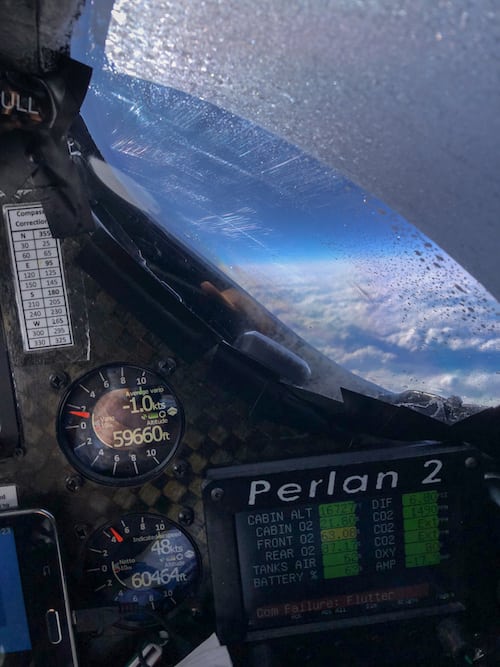
Airbus Perlan Mission II cockpit. (Airbus)
The Perlan Mission II, a technologically advanced glider performing test flights under a project sponsored by Airbus, set a new world record altitude for a glider, reaching 62,000 feet above the Patagonia mountain range in Argentina on August 26. The record-breaking achievement took Perlan II past the Armstrong Line, beyond the altitude within the earth’s stratosphere where human blood will boil if it loses pressurization.
Perlan II is the second-generation glider of the Perlan Project, which is an Airbus initiative to pilot an engineless aircraft to the edge of space, 90,000 feet, or 17 miles above sea level. Its record was achieved with the help of new advanced electronics systems and a special high-altitude tow plane.
The aircraft was released by a high altitude tow plane at 42,000 feet and then glided along stratospheric mountain waves to 62,000 feet. The waves are created by strong winds that blow over the tops of high-altitude mountains and then are driven up toward space.
In comparison to September 2017’s 52,000-foot flight, which previously held the record, the Perlan II team added a new life-support system, a flutter excitation system and a wave-visualization system as well as radio band and telemetry transmitting equipment capable of sending data about its performance to the ground in real time.
“The LX9000, which is soaring instrumentation used on many competition gliders, adapted very easily to the pressurized environment of the Perlan II,” said Morgan Sandercock, a pilot and project manager for the Perlan II.
Perlan II’s LX-9000 is a flight control system with a moving map display that aids the pilots in keeping the glider within the lifting zones of the Argentinian mountain waves. Sandercock, a glider pilot from Australia, also designed a new life support system display for Perlan II’s cockpit that was added for the first time this year. Perlan II has been attempting to reach the edge of space since the test flights began first began in 2015.
Using commercial off-the-shelf (COTS) parts and his own circuit board, Sandercock connected the LSSD display to the aircraft’s data network so that it can show the pilot critical information such as the external temperature or the amount of air left in the cabin air tank.
In the cabin of the glider sits a small computer that analyzes pressurization at a rate of 100 times per second. Using these measurements, it pumps air into the cabin from a Kevlar tank that that team pressurizes at 1,800 PSI on the ground. That keeps the aircraft’s cabin and cockpit pressurized. The air that the pilot breathes goes through a carbon dioxide scrubber and recirculates. This re-breathing system is separate from the Perlan’s pressurization system, according to Sandercock.
“We use a concept a called total energy; the energy of our altitude—height— and energy of our velocity,” said Sandercock,”are added together to come up with a total energy state reading of the glider. The LX9000 instrument uses both pitot and static to add our true air speed. The kinetic energy of our true airspeed is added to our gravitational potential energy so that we can understand how the air around us is carrying us up or down.”
Three inches inside of the glider’s wing tip spars sits a flutter excitation system which is an assortment of stepper motors and accelerometers that provide vibration and performance readings in real time. If these readings meet the expected performance of the Perlan at high altitudes, the aircraft can continue riding mountain waves higher into the stratosphere. Each time it ascends in altitude, new data about how it is performing as well as the outside of the glider is retrieved.
“We treat it kind of like a NASA mission,” said Sandercock, noting that four pilots, two in the air and two on the ground, have a view of the cockpit in real time. While flying, the team has a set of pilots, engineers and weather forecasters on the ground in communication with the pilots ensuring that the glider is performing within a safe flight envelope and they can keep ascending.
The Perlan’s wave-visualization system gives the pilots an idea of where the air is rising and sinking around them. Since the glider has no engine, it is dependent upon staying within the section of the mountain waves that are ascending, which is not an easy task.
“We’re trying to maximize our time within the strongest rising air,” said Tim Gardner, a pilot and simulator programmer for the Perlan II team. The system is used by the pilot via an iPad application, which gives vertical velocity readings.
“Up until this year, that data was only available to us on the ground; we’d be looking at weather models to figure out where the glider was,” said Gardner.
Among the research-related goals is to measure the atmospheric concentration of aerosols and greenhouse gases, including ozone, methane and water vapor. Perlan II will also collect data on exchanges between gases and energy within the two lower layers of the Earth’s atmosphere, the troposphere and stratosphere, according to the Perlan Project website.
The team wants to make as much information about the Perlan’s flights available as possible to advance the science and knowledge behind flying at high altitudes.
“Airbus, being a prime partner with us, is very interested in the aerodynamics side and how the information gleaned from the tests can improve efficiency of aircraft flying at higher altitudes,” Gardner said. “A lot of the information we’re collecting about flying at higher altitudes is of great interest to them.”